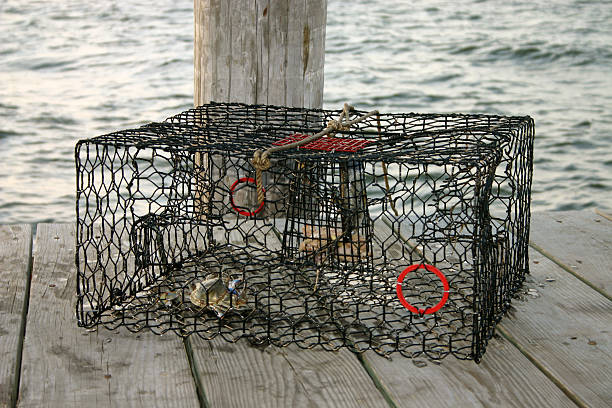Crab traps, also known as crab pots or crab cages, are ingenious contraptions designed to catch crabs effectively and efficiently. Used by recreational and commercial fishermen alike, crab traps come in various designs and materials, each tailored to the specific needs and preferences of the user. In this comprehensive guide, we will delve deep into the world of crab traps, exploring their history, types, construction, usage, and tips for successful crabbing adventures.
A Brief History of Crab Traps
The use of traps to catch crustaceans dates back centuries, with evidence of rudimentary crab traps found in archaeological digs around the world. However, the modern crab trap as we know it today has its roots in the 19th century. In the United States, crab traps gained popularity among commercial fishermen along the Atlantic and Pacific coasts during this time. These early traps were typically made of wood and woven materials such as wicker or mesh.
As technology advanced, so did the design and construction of crab traps. Today, crab traps are often made from durable materials such as wire mesh, plastic-coated steel, or PVC pipe, offering greater durability and longevity compared to their predecessors.
Types of Crab Traps
Crab traps come in various shapes and sizes, each suited to different crabbing conditions and preferences. Some of the most common types of crab traps include:
Wire Mesh Crab Traps: These traps consist of a frame made of wire mesh with one or more entrances for crabs to enter. Wire mesh traps are lightweight, durable, and easy to stack, making them popular among both recreational and commercial crabbers.
Plastic-Coated Steel Crab Traps: Similar in design to wire mesh traps, plastic-coated steel traps offer added durability and resistance to corrosion. These traps are ideal for use in saltwater environments where exposure to seawater can cause rust and deterioration.
PVC Pipe Crab Traps: PVC pipe traps are constructed using PVC pipes and fittings to create a rigid frame with openings for crabs to enter. These traps are lightweight, affordable, and easy to assemble, making them a popular choice for recreational crabbers.
Ring Net Crab Traps: Ring net traps consist of a metal ring with a net attached to it, forming a pouch-like structure. Bait is placed inside the net, and crabs are caught when they enter the ring to feed. Ring net traps are often used in conjunction with other traps or as a secondary method of crabbing.
Construction of Crab Traps
Regardless of the type, all crab traps share a common construction principle: they are designed to lure crabs inside and prevent their escape once captured. The construction of a crab trap typically involves the following components:
Frame: The frame provides the structure and shape of the trap. It is usually made of metal wire, PVC pipe, or plastic-coated steel rods, depending on the type of trap.
Mesh or Netting: The mesh or netting forms the walls of the trap, allowing water to flow freely while preventing crabs from escaping once inside. The mesh size may vary depending on the target species and local regulations.
Entrances: Entrances are openings in the trap through which crabs enter. These entrances are designed to be easy for crabs to navigate but difficult for them to exit once inside.
Bait Chamber: The bait chamber is where bait is placed to attract crabs into the trap. Common baits include fish scraps, chicken necks, or other seafood delicacies that appeal to crabs’ appetites.
Escape Rings or Doors: Some traps are equipped with escape rings or doors that allow undersized or non-target crabs to exit the trap unharmed. This feature helps to promote sustainability by reducing the capture of juvenile or non-commercial species.
Usage of Crab Traps
Using a crab trap effectively requires careful consideration of several factors, including location, bait selection, and trap placement. Here are some tips for successful crabbing with traps:
Choose the Right Location: Look for areas with shallow water, such as marshes, estuaries, or tidal flats, where crabs are likely to congregate. Pay attention to local regulations regarding crabbing locations and seasons.
Use Fresh Bait: Crabs are attracted to fresh, smelly bait, so use bait that is as fresh as possible. Popular bait options include fish heads, chicken necks, or mackerel scraps.
Set the Trap Properly: When setting the trap, make sure it is securely anchored to the bottom to prevent it from drifting away with the current. Use weights or anchors as needed to keep the trap in place.
Check the Trap Regularly: Check your traps frequently, ideally every 1-2 hours, to prevent crabs from escaping or becoming trapped for too long. Remove captured crabs promptly to avoid overcrowding and stress.
Handle Crabs Carefully: When handling crabs, wear gloves to protect your hands from their sharp claws. Hold crabs from the rear to avoid getting pinched, and be mindful of their defensive instincts.
Follow Local Regulations: Familiarize yourself with local crabbing regulations, including size limits, catch quotas, and seasonal closures. Adhering to these regulations helps ensure the sustainability of crab populations for future generations.
Conclusion
Crab trap are indispensable tools for both recreational and commercial crabbers, offering an efficient and sustainable method of harvesting these prized crustaceans. Whether you’re a novice crabber exploring the coastal waters for the first time or a seasoned veteran with years of experience, understanding the ins and outs of crab traps is essential for a successful and enjoyable crabbing adventure. By following the tips and techniques outlined in this guide, you can maximize your chances of catching crabs while minimizing environmental impact and promoting the long-term health of crab populations. So grab your traps, bait up, and embark on your next crabbing expedition with confidence!







